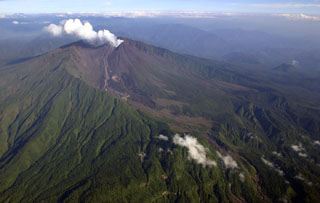Report on Reventador (Ecuador) — 18 June-24 June 2014
Smithsonian Institution / US Geological Survey
Weekly Volcanic Activity Report, 18 June-24 June 2014
Managing Editor: Sally Sennert.
Please cite this report as:
Global Volcanism Program, 2014. Report on Reventador (Ecuador) (Sennert, S, ed.). Weekly Volcanic Activity Report, 18 June-24 June 2014. Smithsonian Institution and US Geological Survey.
Reventador
Ecuador
0.077°S, 77.656°W; summit elev. 3562 m
All times are local (unless otherwise noted)
IG reported that although cloud cover often prevented observations of Reventador, during 18-24 June ash plumes were occasionally observed. At night on 17 June incandescence was observed on the S and E flanks. In the morning of 18 June a diffuse ash plume was visible rising ~600 m above the summit that dispersed to the NW. A total of 30 explosion signatures were recorded by the seismic network, along with long-period (LP) earthquakes and tremor.
Incandescence was observed in the morning of 19 June. The infrared webcamera recorded incandescent material descending onto the NE flank. Residents of San Rafael (8 km ESE) reported roaring sounds from the volcano on 19 and 20 June. The seismic network detected >=18 explosions, >20 LP, and >=7 tremor events per day during 18-24 June.
Geological Summary. Volcán El Reventador is the most frequently active of a chain of Ecuadorian volcanoes in the Cordillera Real, well east of the principal volcanic axis. The forested, dominantly andesitic stratovolcano has 4-km-wide avalanche scarp open to the E formed by edifice collapse. A young, unvegetated, cone rises from the amphitheater floor to a height comparable to the rim. It has been the source of numerous lava flows as well as explosive eruptions visible from Quito, about 90 km ESE. Frequent lahars in this region of heavy rainfall have left extensive deposits on the scarp slope. The largest recorded eruption took place in 2002, producing a 17-km-high eruption column, pyroclastic flows that traveled up to 8 km, and lava flows from summit and flank vents.
Source: Instituto Geofísico-Escuela Politécnica Nacional (IG-EPN)

